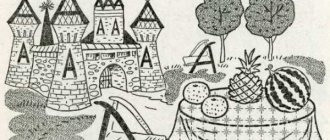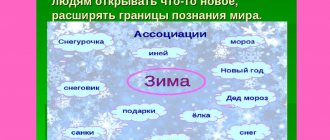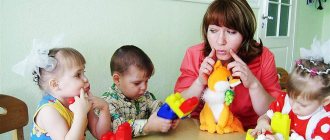Target.
Teach children to highlight the first consonant sound in a word;
introduce the letter Mm;
teach children to select action verbs for the proposed nouns; introduce a conventional (color) designation for hard consonants (blue) and soft consonants (green).
Equipment.
Pictures with sounds [m—m']; sticks; pictures of flowers; markers; sound houses.
Progress of the lesson
I. The teacher invites the children to meet one very interesting girl, Masha, and listen to a story.
1. — Once upon a time there lived Masha. Every day she came up with different games for herself. Today Masha woke up and thought: “Whatever sound I hear first, I’ll be friends with it all day long.” Masha went to the window and saw a cow and a cat. They sat opposite each other and talked. The cow mooed: “Moo-oo!” And the cat answered: “Meow!”
What is the first sound in a cow's song? ([m]).
What is the first sound in a cat's song? ([m']).
Masha smiled: “So today I’m playing and making friends with the sounds [m—m’].” Masha went to the kitchen where her mother was preparing breakfast. She told her mother: “You are the most important in my game, because your word has two sounds at once.”
- What two sounds did Masha mean? ([m]). Where in the word mother
can you hear the sound [m]? (At the beginning and middle of a word)
Masha went out into the garden. She wanted to pick a bouquet of flowers with the sounds [m—m']. Flowers grew in the flowerbed: irises, poppies,
peonies.
- What flowers do you think Masha picked? (Maki) Why? Masha returned with a bouquet of poppies.
I put them in a vase.
And on the table there was already semolina
porridge and
milk.
Masha laughed:
“Mommy,
what a great fellow you are!
You help me
in
my
game."
- Why did Masha say that? (In the words semolina, milk
- first sound [m]).
After breakfast, Masha went to the garden. We need to help mom prepare dinner. Masha
I picked
carrots
for soup,
raspberries
for compote.
- What is the first sound in the words carrot?
and
raspberries?
(Sound [m]).
Coming from the garden, Masha saw that there was pasta
and
meat
. The quick-witted girl realized that her mother would cook pasta the navy way.
— What sounds are heard at the beginning of the words pasta,
meat? (Sounds [m-m']).
Dad arrived at lunchtime. Seeing his daughter, dad asked: “What new game are you playing, Mashenka?”
“I play words with sounds [m—m'],” answered Masha.
“While mom is setting the table, I’ll play with you,” said dad, he sat Masha on his lap and began to ask her riddles. “I was driving through the field and saw this one with the sound [m] in the name:
Little animals
Gray fur coats,
Long tails
Little black eyes,
Sharp teeth. Who is this?" (Mice)
- Masha thought and guessed. Did you guess who Masha's dad saw?
“I brought you a toy. Guess it - it will be yours:
They beat him with a hand and a stick -
Nobody feels sorry for him.
Why are they beating the poor guy?
And because he’s inflated.” (Ball)
- Masha guessed this riddle right away. What about you, children?
2. Children, together with the teacher, compare the sounds [m-m'] in the words we sew
and
a ball.
It is determined that in the first word the sound is pronounced firmly, in the second word - softly.
Articulation of sounds.
When pronouncing sounds [m-m'], the lips are closed; there is an obstacle in the way of the air stream; the air stream seems to tear the lips.
The teacher agrees with the children that sounds whose pronunciation encounters obstacles in the mouth will be called consonants.
As can be seen from the examples, consonant sounds are hard and soft.
Characteristics of sounds.
Sounds [m-m'] - consonants; can be hard or soft.
II. 1. Sound analysis of words mouse
and
a ball
(with markers to color the windows in the houses).
2. Game situation “Focus”.
The teacher draws the children's attention to the diagrams of words on which the vowel sounds [m-m'] are painted over with a blue felt-tip pen.
— You and I discovered that consonants can be pronounced softly and firmly. But this is not visible in our diagram. How can we show that the sound [m] in the first word sounds hard, and in the second - soft, but the sun melted all its hardness?
The teacher takes a yellow felt-tip pen and paints over the blue square in the second word (as if a ray of sun had fallen on it). The blue square turns into green before the children's eyes. After this, a decision is made to designate soft consonants in green, and hard consonants remain blue. Red, as before, denotes a vowel sound.
III. Consolidation of new material.
1. The teacher offers to select and name from a pair of words those that begin with the sound [m'].
Example word pairs: oil
-
meat, poppy
-
ball, sea
-
stranded, mouse
-
bear, car
-
subway
, etc.
2. The teacher shows pictures with the sound [m] - the children select action verbs for them. For example: fly
-
flew, buzzed, got bored.
An approximate set of words: car (drove, stopped, carried), carrots (grew, turned green), pasta (lay, boiled, fried), mouse (ran, squeaked), boy (jumped, ran, drew, slept, played)
and etc.
IV. 1. Getting to know the image of a letter. The teacher asks the children:
- Do you think the sound [m] has its own sign - a letter? Does the sound [m'] have its own letter? I'll tell you the secret of our language: in Russian, hard and soft sounds are denoted by one letter. Now I will show you the letter that represents the sounds [m-m']. Display a demonstration letter and place it on the panel at the address: fourth floor (fourth row from the bottom), apartment No. 2 (second cell from the left). The flats for letters denoting consonant sounds are highlighted in blue.
2. Analytical and synthetic activities.
V. Game exercise “What elements does an object consist of?”
Goal: to train children in the ability to analyze an image and isolate its constituent elements.
The teacher draws schematic images of various objects (table, chair, snowman, etc.) on the board and asks them to answer the questions: what elements does the image of each object consist of? How many elements are there in total?
Project “City of Letters” - all about the letter “M” for 1st grade
Project goal: To get acquainted with all the letters of the Russian alphabet and choose your favorite letter.
Draw and talk about her character, as well as behavior in the City of Letters, having learned about her from the works of the textbook “Literary Reading”. Make a letter layout, prepare a report for a speech and a presentation with illustrations. Project execution plan:
- My favorite letter
- Let's make a letter layout from cardboard.
- Character of the letter "M".
- Poems about the letter "M".
- Riddles about the letter "M".
- Text about the letter “M” for the Museum of Letters.
- An example of a finished presentation.
Report to the project
I chose the letter “M” for the Museum of Letters. Because she is my favorite. Various writers have said a lot of interesting things about this letter.
The word Mouse begins with the letter M, which denotes a rodent fleeing from a cat in V. Danko’s poem.
The Merry Masquerade was started by the letters in Sasha Cherny's poem.
The letter M is a consonant and cannot be sung.
But you can Moo it, as the chicken did in I. Gamazkova’s poem.
In S. Marshak's poem, the word Bear, who threatened to eat all the other passengers, begins with the letter M.
Also, the words Courage, Mom, Raspberry, and Ball begin with this letter.

![Summary of a lesson on speech development for children 4–5 years old “Sound culture of speech: letter [p]”](https://dou31-orel.ru/wp-content/uploads/konspekt-zanyatiya-po-razvitiyu-rechi-dlya-detej-4-5-let-330x140.jpg)


